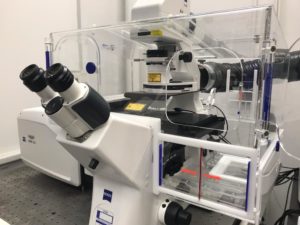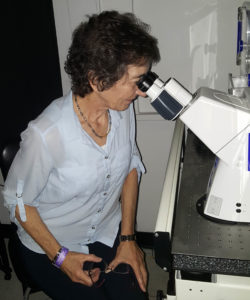
My brother, Laurence Braude, was an ophthalmologist, cornea specialist, surgeon and researcher. At 47, he complained of fatigue and weakness in his left arm and leg. His internist referred him to a neurologist who said he had Parkinson’s.
Laurence retired from his ophthalmology practice to care for his health. He also set up a foundation to fund basic medical research on brains and neurological disorders. As an associate professor, Laurence was extremely interested in furthering science through basic research.
After establishing the Braude Foundation, my brother and I attended a day long Foundations 101 seminar through Exponent Philanthropy. It spurred our crafting a mission statement and grant process, and we received a basic understanding of the 990-PF tax form, plus the need to set up an accounting system.
The foundation gave to several medical institutions and organizations while Laurence was alive. He died three years later. I took over the foundation and established a board to continue his mission.
Neurological misdiagnoses
Laurence’s symptoms did not improve with Levodopa, a medicine considered the gold standard for Parkinson’s. This led to several misdiagnoses: Young Onset Parkinson’s; Parkinsonism unresponsive to Sinemet; vascular Parkinson’s disease; striatum degeneration; idiopathic Parkinson’s; and finally Multiple System Atrophy.
Laurence insisted on having an autopsy of his brain when he died.
At first, I was hesitant. But he said it was the only way to establish a definitive diagnosis. He wanted his physicians to compare the report to their notes and original findings.
The autopsy revealed Laurence had Lewy body dementia. No doctor had told us this.
Through this experience, I grasped importance of brain autopsies.
Over a quarter of patients with neurological disease are misdiagnosed. For example, those with Alzheimer’s are diagnosed with Parkinson’s, and vice versa.
I sent the report to his doctors. They were all very thankful. In fact, one gave a lecture to colleagues in Europe about his misdiagnosis, the difficulties of making an accurate neurological diagnosis, and the importance of brain donations.
Bringing awareness to brain donation
The cost of harvesting the brains of patients who die in nonhospital settings falls to their families. I realized that in order to get more brains donated, the foundation could cover this expense.
Our board visited Parkinson’s support groups to encourage patients and their loved ones to donate their brains. The organizers and caregivers initially resisted this morbid topic, but patients were usually very supportive.
Our first few years championing brain donations didn’t seem all that impactful. But we kept at it. Seventeen years later, I am thrilled to say this is no longer a controversial topic. It’s discussed regularly at support groups.
Recently at a conference, several researchers emphasized the need for brain donations for their studies. Some referenced the Braude Foundation’s help, an enormously proud moment. This is a major turnaround from our first year at the same conference when they said,
“Nobody wants to talk about brain donation.”
Funding basic medical research equipment
Over the years, I became acquainted with a researcher and primary investigator at Johns Hopkins Medical School. She said funding from the National Institutes of Health covered salaries, but not equipment. I asked her,
“What do you need for your research?”
“A microscope,” she said.
I imagined my high school microscopes.
“Zeiss makes a good one for $150,000.”
We’re a small foundation with assets under $2 million, and annual grants totaling $100,000. We used two years of funding to finance the microscope. The researcher was ecstatic.

She and her colleagues used the microscope to study living nerve cells. They identified a growth mechanism in adults that was thought to only exist in embryos. This growth is closely related to the mechanism specifying the DNA in autism.
The discovery led to a revolutionary biological definition of autism, and the researchers were published in Cell, one of the most prestigious peer-reviewed scientific journals, for their groundbreaking work.
Next, the researchers requested funds for a mouse model, more work the NIH would not support. The project was still in its early stages and had a high risk of failure. But the foundation stepped up with $75,000 to facilitate its creation. The researchers used it to:
- Design DNA to allow inducible alteration of neuronal function
- Inject the DNA into mice
- Verify that the mice and their offspring had the DNA, and expand the colony
-

By expanding the mice’s linage, and crossing with other mouse lines, the lab could conduct valuable experiments on their brain cells. Live nerve cells were extracted, grown in the laboratory, observed, and imaged with the microscope over several days. Graduate students also penned and published more articles in reputable peer reviewed journals.
It’s been 13 years since we funded this microscope and the maker has a new, better model. Last year, the foundation was asked to fund this latest microscope for $250,000. It enthusiastically approved with a multiyear commitment.
The power of a singular focus
The Braude Foundation has achieved an outsized impact through our sustained support and singular focus.
One researcher explained how our grant impacted their work:
“Sustained, flexible support is invaluable. Scientific questions don’t usually yield their secrets immediately; it takes sustained effort. Flexible support can better suit the needs of the lab and the science at a particular point in time, creating greater impact. Small funders can also enable exploratory research that delves into innovative and promising areas, where there is not yet sufficient data for NIH support.”
Interactions with small funders also provides a bidirectional educational experience. From the perspective of a scientist:
“I see how your sustained interaction with our lab has helped trainees see the importance of understanding how to communicate with a broader audience (which has long-term impacts for society and the perceived value of science.) This meaningful experience has catalyzed several members of our lab to engage in further interactions with community members outside of science.”
Solna Braude is president of the Braude Foundation. We support high quality biomedical research—monitored by recognized peer review evaluations for ethical and appropriate studies—to understand biological systems and enhance health worldwide.

Excellent article on an essential topic. To make an impact, set a mission and use a few, or one, substantial grants and fund over several years. That will make a significant long range difference. Great job Braude Foundation!
I was very lucky to meet and get to spend time with Solna quite some time ago. She is all heart with a remarkable intelligence and a focus on things that impact her life, family, friends and the many many people that she opens doors for.
Well done my friend!
I am so fortunate to be able to call her my friend